Acid-base homeostasis orchestrated by NHE1 defines the pancreatic stellate cell phenotype in pancreatic cancer
- PMID: 37643024
- PMCID: PMC10619433
- DOI: 10.1172/jci.insight.170928
Acid-base homeostasis orchestrated by NHE1 defines the pancreatic stellate cell phenotype in pancreatic cancer
Abstract
Pancreatic ductal adenocarcinoma (PDAC) progresses in an organ with a unique pH landscape, where the stroma acidifies after each meal. We hypothesized that disrupting this pH landscape during PDAC progression triggers pancreatic stellate cells (PSCs) and cancer-associated fibroblasts (CAFs) to induce PDAC fibrosis. We revealed that alkaline environmental pH was sufficient to induce PSC differentiation to a myofibroblastic phenotype. We then mechanistically dissected this finding, focusing on the involvement of the Na+/H+ exchanger NHE1. Perturbing cellular pH homeostasis by inhibiting NHE1 with cariporide partially altered the myofibroblastic PSC phenotype. To show the relevance of this finding in vivo, we targeted NHE1 in murine PDAC (KPfC). Indeed, tumor fibrosis decreased when mice received the NHE1-inhibitor cariporide in addition to gemcitabine treatment. Moreover, the tumor immune infiltrate shifted from granulocyte rich to more lymphocytic. Taken together, our study provides mechanistic evidence on how the pancreatic pH landscape shapes pancreatic cancer through tuning PSC differentiation.
Keywords: Epithelial transport of ions and water; Fibrosis; Homeostasis; Metabolism; Oncology.
Conflict of interest statement
Figures
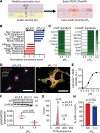

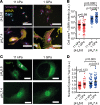
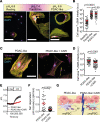

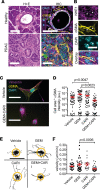
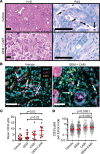
Similar articles
-
A CNA-35-based high-throughput fibrosis assay reveals ORAI1 as a regulator of collagen release from pancreatic stellate cells.Matrix Biol. 2025 Feb;135:70-86. doi: 10.1016/j.matbio.2024.12.004. Epub 2024 Dec 9. Matrix Biol. 2025. PMID: 39662708
-
Meflin is a marker of pancreatic stellate cells involved in fibrosis and epithelial regeneration in the pancreas.J Pathol. 2024 Jan;262(1):61-75. doi: 10.1002/path.6211. Epub 2023 Oct 5. J Pathol. 2024. PMID: 37796386
-
Heat Shock Protein-90 Inhibition Alters Activation of Pancreatic Stellate Cells and Enhances the Efficacy of PD-1 Blockade in Pancreatic Cancer.Mol Cancer Ther. 2021 Jan;20(1):150-160. doi: 10.1158/1535-7163.MCT-19-0911. Epub 2020 Oct 9. Mol Cancer Ther. 2021. PMID: 33037138 Free PMC article.
-
Pancreatic stellate cell: Pandora's box for pancreatic disease biology.World J Gastroenterol. 2017 Jan 21;23(3):382-405. doi: 10.3748/wjg.v23.i3.382. World J Gastroenterol. 2017. PMID: 28210075 Free PMC article. Review.
-
Pancreatic stellate cells and pancreas cancer: current perspectives and future strategies.Eur J Cancer. 2014 Oct;50(15):2570-82. doi: 10.1016/j.ejca.2014.06.021. Epub 2014 Aug 1. Eur J Cancer. 2014. PMID: 25091797 Review.
Cited by
-
Piezo1-induced durotaxis of pancreatic stellate cells depends on TRPC1 and TRPV4 channels.J Cell Sci. 2025 Apr 15;138(8):jcs263846. doi: 10.1242/jcs.263846. Epub 2025 Apr 25. J Cell Sci. 2025. PMID: 40019468 Free PMC article.
-
Piezo1-induced durotaxis of pancreatic stellate cells depends on TRPC1 and TRPV4 channels.bioRxiv [Preprint]. 2024 Apr 15:2023.12.22.572956. doi: 10.1101/2023.12.22.572956. bioRxiv. 2024. Update in: J Cell Sci. 2025 Apr 15;138(8):jcs263846. doi: 10.1242/jcs.263846. PMID: 38187663 Free PMC article. Updated. Preprint.
-
K2P2.1 channels modulate the pH- and mechanosensitivity of pancreatic stellate cells.Pflugers Arch. 2025 Jan;477(1):147-157. doi: 10.1007/s00424-024-03021-z. Epub 2024 Sep 26. Pflugers Arch. 2025. PMID: 39325089 Free PMC article.
References
-
- American Cancer Society. Cancer Facts & Figures 2023. https://www.cancer.org/content/dam/cancer-org/research/cancer-facts-and-... Accessed August 30, 2023.
Publication types
MeSH terms
Substances
LinkOut - more resources
Full Text Sources
Medical
Molecular Biology Databases
Miscellaneous

